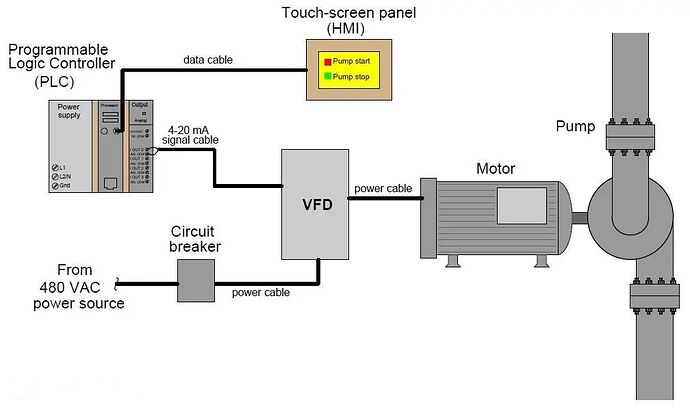There are five ways to control a Variable Frequency Drive (VFD) with a Programmable Logic Controller (PLC):
Analog Signal Control (0-10V/4-20mA)
- PLC outputs analog signal: 0-10V or 4-20mA.
- VFD receives signal: Adjusts frequency accordingly.
- Common applications: Speed control, ramping, and modulation.
Digital Signal Control (Discrete Inputs)
- PLC sends digital signals: Start/Stop, Forward/Reverse, etc.
- VFD receives signals: Executes corresponding actions.
- Common applications: Simple on/off control, direction control.
Modbus Communication
- PLC and VFD communicate: Via Modbus RTU/TCP protocol.
- PLC sends commands: Frequency setpoints, start/stop, monitoring.
- VFD responds*: Confirms receipt, executes commands.
- Common applications: Advanced control, monitoring, and diagnostics.
BACnet/IP or EtherNet/IP Communication
- PLC and VFD communicate: Via BACnet/IP or EtherNet/IP protocol.
- PLC sends commands: Frequency setpoints, start/stop, monitoring.
- VFD responds: Confirms receipt, executes commands.
- Common applications: Building automation, industrial control.
PROFIBUS or DeviceNet Communication
- PLC and VFD communicate: Via PROFIBUS or DeviceNet protocol.
- PLC sends commands: Frequency setpoints, start/stop, monitoring.
- VFD responds: Confirms receipt, executes commands.
- Common applications: Industrial automation, process control.
Additional Considerations
- Ensure compatibility: Verify PLC and VFD compatibility.
- Configure communication: Set up communication protocols.
- Program PLC logic: Develop control logic.
- Test and commission: Verify proper operation.
Popular PLC and VFD combinations
- Allen-Bradley PLC with Rockwell Automation VFD
- Siemens PLC with Siemens VFD
- Mitsubishi PLC with Mitsubishi VFD
- Schneider Electric PLC with Schneider Electric VFD
- Omron PLC with Omron VFD
